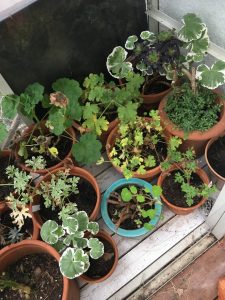Frosts really must be starting later, as I am sure that by this time in previous years I would have been forced to bring all of my tender plants into the greenhouse by increasing threats of icy nights and early mornings. Only in the last week or so has it felt cold and gloomy enough that I feel like I should, but with no hint of an actual frost here yet. However, it can’t be far away now, and so I have taken a morning and tucked all of my tender favourites away for the winter in my mini greenhouse, which lives up by the house, along the kitchen wall. I imagine that snuggled up there my plants are cosier, as they have a little bit of warmth from the house, the small effects of which might just keep a frost at bay a little longer than if they were down at the end of the garden.
I have a particular weakness for pelargoniums and aeoniums, which are tricky to get through winter not because they are extremely tender and need warmth but because they are slightly on the edge. In a mild year in a city (and I live in Bristol which is even milder than most) aeoniums can often survive outside. There is one house that I used to pass on my kids’ school run with a row of aeoniums on the windowsill. I would will them to take them in in November, will harden in December, but watched them sail right on through January and February unharmed. But of course this depends upon the year, and there is no guarantee that a hot summer and late frosts equal a mild winter. Equally though they hate to be in the house. I have tried it, and watched them slowly become more dessicated and lifeless as the winter months tick on. They hate the stuffiness and hate central heating. If I had a porch I would put them in that, and an unheated or barely heated conservatory is perfect. But I don’t, so I put mine into my mini greenhouse.

The first thing to do those is to check them all over. Any bugs will thrive in the relative warmth and protection of the greenhouse and so it is important to look over the leaves carefully to make sure nothing is lingering. I also scrape off the top layer of compost, in case anything is harbouring there. And then I pack them in, cheek by jowl. In a larger greenhouse it is really important to line with bubble wrap at this time of year. This traps a layer of air, which helps to keep the insides relatively warm. I tend not to do this on the little greenhouse, just because it is so small that it is really easy to throw a blanket over it on colder nights. I generally don’t heat it, but I have placed the plants onto a propagation mat that I can plug in in spells of really cold weather. This provides very low levels of heat and is pretty cheap to run (or at least it has been in the past…). Really cold snaps are generally fairly short lived, and so it is worth a tiny bit of heat for a few days in order to save the plants.
I also have reams of horticultural fleece to hand now. As the weather gets colder I will tuck this around the plants to provide another insulating layer, so helping them to keep warm enough to last out well until warmer and brighter days come our way again.


